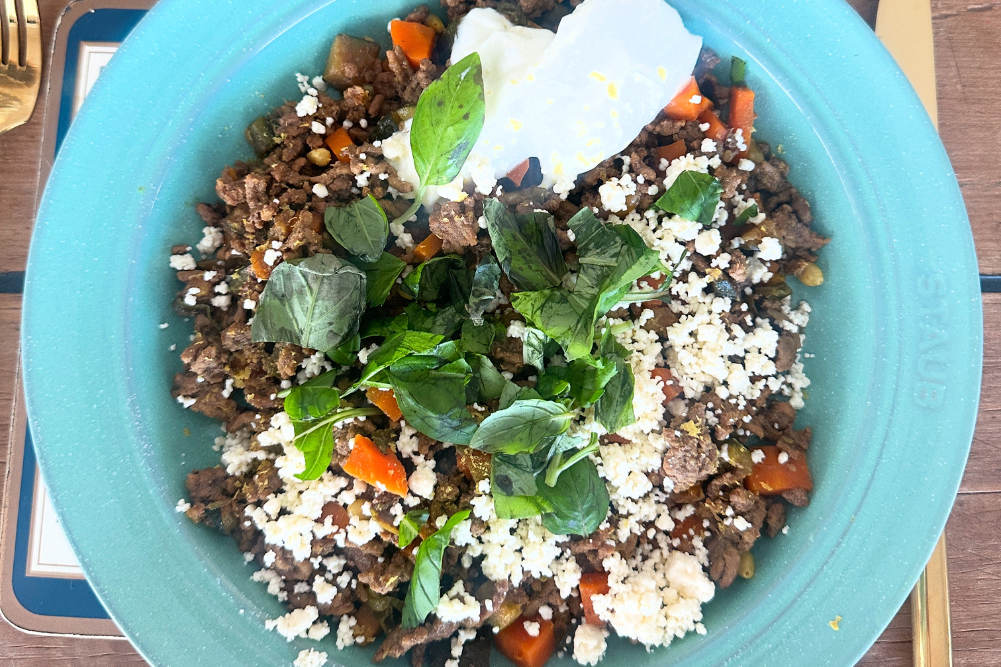The real Mediterranean diet
The first detailed study of this storied heart-healthy diet goes all the way back to the 1940s on Crete — the largest of the Greek islands in the Mediterranean. Find out what the island’s inhabitants were doing so right. Their lessons might astonish you.
In the spring of 1948, an American social scientist named Leland Allbaugh departed for the island of Crete with the intention of fixing it. At the time, Greeks had the lowest per capita income in Europe and Cretans had the lowest income in Greece. Malaria and “diseases of filth,” like dysentery, were widespread. All this led Allbaugh to conclude in a letter to his Rockefeller Foundation funders that “the Cretans have a potential need for almost everything.” In an attempt to catalogue those needs, Allbaugh carried out seven months of intensive field research. Fanning out across the spare, rocky land, he and his team visited farmers’ fields and workers’ factories, monitored the care of the sick and counted up the ways the moribund had died.
But most important, the Allbaugh group exhaustively inventoried what the Cretans ate. Expecting to find widespread malnutrition, the researchers instead discovered the local diet to be “surprisingly good” and noted that the Cretans had an exceedingly low rate of chronic Western diseases. They suffered about a third as many heart-disease-related deaths as Americans at the time and had barely any incidence of cancer. No matter how underdeveloped Crete might have been in terms of roads, plumbing and other typical markers of “progress,” it seemed they were far ahead of the US when it came to eating well.
And they’d been eating this well for millennia: “The basic foods for the modern Cretan diet are probably the same as during the Minoan period, about 2000 B.C.,” Allbaugh wrote in Crete, the 572-page book outlining his findings. This diet would be analysed in an even deeper way a decade later, when University of Minnesota physiologist Ancel Keys, Ph.D., travelled to Crete to interview men from the island’s heartland. Once again, subjects were found to be lean and largely free of heart disease and cancer. So healthy were the Cretans that Keys used them as a pilot population for his epic “Seven Countries Study” — the first detailed analysis to compare diet and health outcomes across a broad spectrum of nations. Keys cited Cretans repeatedly as ideal practitioners of a lifestyle that he and his wife, Margaret, termed “the Mediterranean Way.”
Ever since, we’ve been captivated by what has come to be known as the Mediterranean diet. And medical researchers continue to build a huge body of evidence around Allbaugh’s and Keys’s findings. More than 6,500 scientific papers have been published on the Mediterranean diet, including the 1998 Lyon Diet Heart Study — the first clinical trial on the subject and one that’s still cited today. It found a 50 to 70% reduction in rates of heart disease and stroke recurrence among those following a Mediterranean diet.
Then there was the landmark 2013 PREDIMED study, which observed a 39% reduction in heart attacks in healthy individuals who added key Mediterranean components (namely nuts and olive oil) to their diets.
(The paper was retracted and later republished to correct a flaw in the randomisation process, but the results remained the same.) Evidence has also linked a Mediterranean style of eating to improved cognition. And a population-level study published in the New England Journal of Medicine stated bluntly that “greater adherence to the traditional Mediterranean diet is associated with a significant reduction in total mortality.” It is due to this and other research that U.S. News & World Report has ranked the diet best in the world for the past three years.
But despite all the acclaim, most Americans remain confused about what a Mediterranean diet really is. Apart from a vague sense of olive oil and red wine being a good idea and a big slab of red meat being a bad one, we often just pick and choose healthy- sounding foods from any one of the countries that the Mediterranean Sea touches without having an organising principle.
So in an attempt to offer some more concrete advice, I journeyed to Crete to find out exactly what Cretans were eating when Allbaugh and Keys found them in the peak of health. What I learned is that while much of the Cretan tradition can be quixotic and even a little arbitrary, there are specific changes we can make to our own diet that will bring us more in line with the Mediterranean ideal.
Eat plenty of carbs — but the right carbs
“This really is the base of the original Cretan diet,” archaeologist Dimitra Mylona, Ph.D., said as she handed me a tough, thick cracker in the dank chamber of a Minoan tomb a few miles outside the Cretan town of Rethymnon. For the past 20 years, Mylona has been looking at the eating habits of the early inhabitants of the island, through her work with the Institute of Aegean Prehistory Study Center. What she concluded is that it was the rough barley bread, or rusk, that formed the backbone of the diet. “You can see it in their teeth,” she told me. “They’re worn down and damaged from chewing on this hard stuff.” Indeed, Allbaugh found that 39% of Cretans’ daily calories came from whole grains.
Whereas wheat was typically
eaten by the upper classes or exported, barley was the food of the commoners. This whole grain made for a bread that was slower to digest and less likely to cause the insulin spikes of white flour — thanks largely to barley’s high amounts of soluble fibre, nearly twice that of whole wheat. “Fibre has all sorts of benefits in terms of appetite and weight control,” explained EatingWell adviser David Katz, M.D., M.P.H., director of Yale University’s Yale-Griffin Prevention Research Center in the US. Soluble fibre extends the time your body takes to break down carbs and “smooths out” the digestion of sugars and fats, helping you feel fuller longer.
Whole grains high in soluble fibre also have proven heart-health benefits. A recent review of 243 studies published in The Lancet found that people who ate the most fibre had a 15% to 30% lower risk of death from heart disease. And the research showed a similar reduction in risk of developing cardiovascular disease, type 2 diabetes and colon cancer. High fibre intake was also linked to lower body weight and lower blood pressure and cholesterol. All of this resulted in a population that Allbaugh described as “slim-waisted, erect and able to withstand hunger during war and revolutions.”
LESSON: While ample carbohydrates were part of the Cretan diet, the vast majority were from whole grains rich in soluble fibre. Meanwhile, just 16% of the grains Americans eat, for example, are whole — the rest are refined. Katz said you can follow the Cretan example by switching to 100% whole-wheat bread products and aiming for at least one daily portion of nonwheat grains, like oats or barley. And shoot for around 28 total grams of fibre per day.
Curb added sugar
Arguably as important as the type of carbs Cretans ate is the kind they did not. Namely, sugar. Allbaugh recorded a minuscule 50 calories a day from foods like honey and grape must in the local diet — about 3 teaspoons’ worth of added sugar. The average American currently gets 23 teaspoons’ worth of added sugar daily (more than the Greeks ate in a week). “Cretans do not serve desserts — except for fresh fruit in season,” Allbaugh observed. “Cake is seldom served and pie almost never.” Even Greek yoghurt — one of their culinary claims to fame — was eaten plain.
Too much sugar in the diet has obvious implications for developing type 2 diabetes, but a 15-year-long study published in JAMA Internal Medicine found an association between added sugar and heart disease as well. Those eating a diet high in these refined carbs (about 17% to 21% of daily calories) had a 38% greater risk of dying from heart disease than those who got just 8% of their calories from added sugar. Research Keys and his colleagues conducted decades earlier for the “Seven Countries Study” also revealed an association between sugar intake and cardiovascular disease, albeit a weaker one than for dietary sources of saturated fat.
LESSON: Look for ways to trim added sugars from your diet — including those that may be lurking in your flavoured “Mediterranean” Greek yoghurt. (Some pack as much per serving as a chocolate bar.) The American Heart Association recommends limiting added sugars to 25 grams daily for women and 36 for men, or about six and nine teaspoons’ worth. So read labels on packaged items and choose ones with the lowest amount, because those grams can add up quickly.
Expand your fruit and vegetable repertoire
Under a canopy of 350-year-old olive trees just outside the city of Chaniá, another food- and gastronomy-focused archaeologist, Mariana Kavroulaki, explained that after the Minoan period of self-government ended around 1450 B.C., Cretan food habits were dictated by harsh socioeconomic conditions imposed by the island’s later colonisers.
Over the centuries, Crete was conquered and occupied again and again. The island’s overlords — Romans, Venetians, Ottomans —
all used Crete as a giant plantation, sending the most highly prized agricultural products, such as lemons, figs and raisins, abroad. As a result, Cretans had to eat whatever other foods were left.
But it turns out what was left had great nutritional benefits. Perhaps the greatest example is the wild field greens known as horta that women gathered in the winter and spring months. Spicy and bitter, succulent and sour, horta encompass a broad array of more than 100 edible plants. Some, like purslane, contain high amounts of short-chain omega-3 fatty acids, which have been shown to help reduce blood pressure and cholesterol levels and lower the risk of heart disease and type 2 diabetes. Other greens, like dandelion, have antioxidants that may play a role in warding off cancer.
A wide variety of horta in the diet contributed significantly to the longevity Cretans enjoyed, according to Antonia Trichopoulou, M.D., Ph.D., a prolific Mediterranean diet researcher and president of the nonprofit Hellenic Health Foundation. A study she conducted, published in BMJ, found that high consumption of plants (including greens, as well as onions, tomatoes, cabbage and eggplant) accounted for the largest reduction in early mortality risk compared to the other beneficial aspects of the traditional Mediterranean diet, such as low meat consumption and liberal olive oil intake.
When it came to fruit, Allbaugh noted that the most-consumed items were grapes, pomegranates and melons, all of which score an impressive 118 or higher on the Aggregate Nutrient Density Index (ANDI), a system that rates foods based on their nutrient content. Contrast that with the US, for example, where the current top three fruits — apples, oranges and bananas — have ANDI scores of 53, 98 and 30, respectively.
The individual healthy components of the different fruits and vegetables that were eaten by Cretans were amplified by the sheer quantity they consumed — on average, 432 pounds (195 kilograms) of produce per person annually. Around that time, Americans were eating 323 pounds (146 kilograms) and today we get around 220 (100 kilograms). (These totals don’t include potatoes, which were — and are — popular with both groups.)
LESSON: The Cretans were models of plant-forward eating long before it was a thing in the US. (Author Michael Pollan’s oft-quoted maxim to eat “mostly plants” is, by his own admission, derived from the first Crete studies that went on to inspire our modern dietary guidelines.) So: up your produce intake. According to a meta-analysis in BMJ that looked at data from nearly 470,000 people, for every daily serving of fruits and vegetables consumed, the risk of dying from heart disease dropped by 4% and the odds of premature death from any cause fell by 5% (with a maximum benefit at about five servings a day). And go for variety. Despite the many types of produce available to us today, we often stick to the same ones, and not the most nutritious ones at that.
Michael Greger, M.D., author of How Not to Die, suggests rotating as many different colourful fruits and vegetables through your diet as possible to get a broad range of vitamins and minerals. And, generally, the brighter or deeper the pigment — like the dark, leafy horta — the more phytonutrients the food will contain.
Enjoy a little krasí
Perhaps the greatest point of controversy regarding the Mediterranean diet is the inclusion of red wine (krasí) as an integral component — so much so that it’s treated like a nutrient. Over the past 70 years, studies have gone back and forth on the benefits of alcohol (of any kind). Some have found that moderate amounts — about a drink a day for women and two for men — can lower heart disease risk, while others have found no such benefit, or even harm.
What we do know, because Allbaugh recorded it, is that most of the wine Cretans drank was red and they always had it with food. This is important because some research suggests there may be a synergistic effect between wine and food that promotes heart health better than sipping it on its own. Red wine is also rich in polyphenols — antioxidants including anthocyanins and oleocanthal, the same compound as in olive oil — that have been found to keep platelets from building up and clotting blood vessels and to improve cholesterol and blood vessel function, all of which are cardioprotective. Concentrations of these polyphenols are about 10 times higher in red wine than white (although the latter has beneficial compounds of its own).
Also worth noting: regular wine consumption clearly enhanced a general culture of intergenerational sociability — another key pillar in the health and welfare of long-lived Mediterraneans. But while red wine was had at multiple meals daily, alcohol accounted for only 1% of total calories. (Allbaugh did suspect the Cretans underreported how much they drank because they felt “the visiting Americans might be expected to frown upon heavy wine consumption.” By his observations, they had about one small glass a day.)
LESSON: If you don’t drink, this is not a reason to start. But if you enjoy the occasional glass of red over a meal with friends and family, it could improve the quality of your life and possibly the length of it.
Choose good fat, not low fat
Another dozen miles up the road toward Crete’s western shore stands the Olive Tree of Vouves. As big around as a station wagon and estimated at more than 3,000 years old, it is an enduring testament to the fundamental role that olive oil has played in the Cretan diet.
Indeed, Allbaugh noted that “to the foreign visitor, food seemed literally to be ‘swimming’ in oil.” And when Keys made his observations, he found as much as 40% of daily calories came from it.
Emmanouil Karpadakis, an olive oil tasting expert at Terra Creta olive oil cooperative in Chaniá, told me that 1940s-era Cretans were likely to be consuming olives harvested when still green, and thus richer in antioxidants. As Katz later explained, these greener olives would have contained higher amounts of a compound called oleocanthal, a highly potent antioxidant that gives olive oil its slightly bitter edge.
Oleocanthal has been shown to have anti-inflammatory effects that play a significant role in reducing the risk of chronic diseases, including heart disease, type 2 diabetes and certain kinds of cancer.
According to a study published in the Journal of Agricultural and Food Chemistry that compared oleocanthal levels in both early- and late-harvest Greek olive oils, batches made from green early-harvest olives had nearly twice as much of the compound than oil from those picked later (however, even the oil made from late-harvest olives still had significant amounts of oleocanthal).
LESSON: Embrace extra-virgin olive oil and swap it in for less- healthy fats in your diet, such as butter. It’s also worth looking for “early harvest” EVOO that has been extracted from green unripe fruit, to get the highest amount of oleocanthal and other important antioxidants. While this is not a regulated term, you can often taste the difference — the flavour will be grassy and astringent compared to regular olive oil’s buttery mellowness.
Embrace the bean and nut
Greeks often joke that in the rocky highlands of Crete “there are more goats than Greeks.” Goats were the first domestic animal the Minoans brought to the island some 3,000 years ago and are such a part of Cretan identity that the wild version of the species, known as the kri-kri, is nationally protected. Keys and Allbaugh both observed how central the goat was to island animal husbandry, and that its meat was lean and nutrient-dense. Overall, goat meat has less total fat and saturated fat, more iron and about the same amount of protein per ounce compared to beef, pork, lamb and chicken. So Cretans would have had less sat fat — which can drive up cholesterol levels — in their diets.
But the more important point from a health perspective is that even this high-quality meat was seldom on Cretan plates, according to Walter Willett, M.D., Dr.P.H., a professor of epidemiology and nutrition at Harvard University’s T.H. Chan School of Public Health in the US, who is perhaps the nation’s top expert on the Mediterranean diet. Specifically, Allbaugh observed that the Cretans only ate a little over seven ounces (200 grams) of goat or other red meat a week. Even fish, often imagined as a key part of this diet, was consumed in small quantities — about six ounces (170 grams) weekly. And at around 2 ounces (56 grams) a week, poultry was even more of a mealtime rarity. The bulk of their protein came from legumes — chickpeas, white beans, fava beans, lentils — and other types of pulses, as well as nuts, including almonds, walnuts and chestnuts. Like whole grains, beans, legumes and nuts are rich in soluble fibre and phytonutrients that may reduce the risk of various diseases, particularly when substituted for meat. The PREDIMED study reached this conclusion.
LESSON: While you probably won’t find goat in your local supermarket, you can choose lean cuts of meat and eat animal proteins sparingly — Dr. Willett recommends no more than one serving a few times a month. Instead, make beans, legumes and nuts your principal protein sources.
Watch how much you eat — as well as what you eat
When Allbaugh distilled the many interviews his team did over the course of his time in Crete, the grim statement that stands out from one of his subjects was, “We are hungry most of the time.” Overall intake was 2,547 calories per day — on par with average daily intake in the US today. But many Cretans did backbreaking physical work every day that would necessitate many more calories than this.
Cretans also tended to spread their food out into six small meals, rather than sit down to three large ones, which many contemporary physicians recommend. A study in the Journal of the Academy of Nutrition and Dietetics found that people who ate at least six times a day had better overall diet quality and lower BMIs than those who ate fewer than four times daily. Other research has shown that small, frequent meals may improve cholesterol and insulin levels. Plus, Cretans observed a pattern of religious fasting that closely mirrors the 5:2 pattern of intermittent fasting that some research has shown can promote longevity and reduce blood sugar levels. In the Greek Orthodox calendar, both Wednesdays and Fridays are designated as fast days and there are also numerous religious holidays that require abstention.
LESSON: Keep calories in check and consider eating smaller, more frequent meals. You can also ask your doctor whether intermittent fasting might be right for you.
Will these seven dietary lessons from Crete turn you into a slim-waisted, super-fit individual free of heart disease and cancer — and propel you headlong into a healthy old age? Well, it could be a start. There were many factors that contributed to the longevity Allbaugh and Keys observed on Crete, including strong family and social ties, relatively low stress levels and a penchant for dancing. But for the moment, the easiest thing we can do to emulate the inhabitants of King Minos’s ancient island is to change how we eat. The rest, like the basis of so much traditional Greek yoghurt, is culture.








